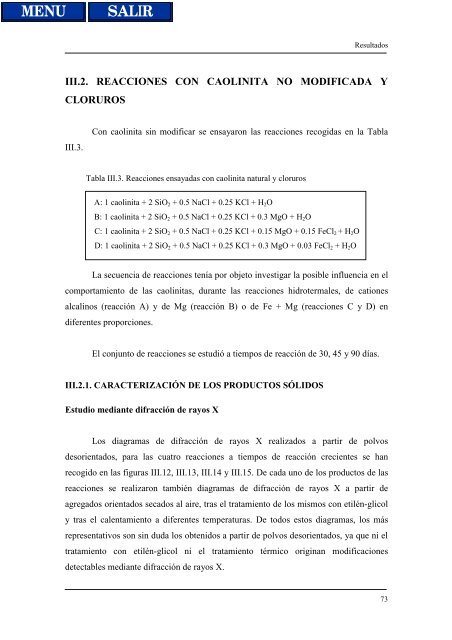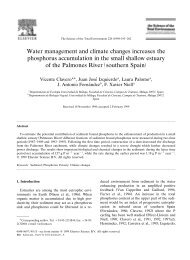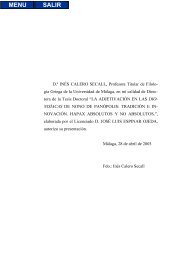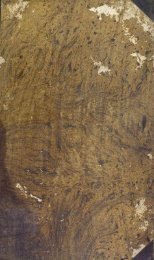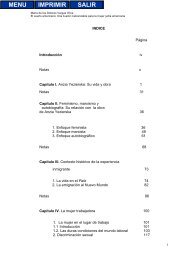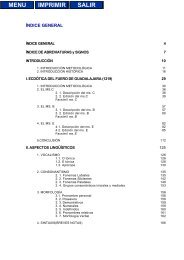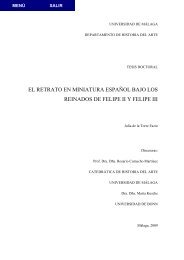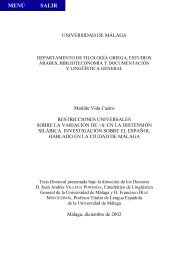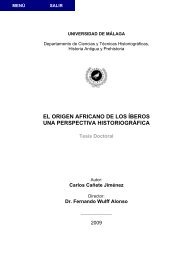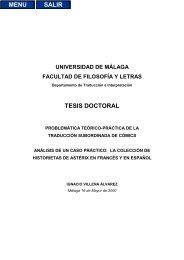- Page 1:
Tesis Doctoral TRANSFORMACIONES HID
- Page 5:
AUTORIZACIÓN DE LOS DIRECTORES DE
- Page 9:
AGRADECIMIENTOS Esta memoria ha sid
- Page 12 and 13:
II.3.4. Diagramas de actividad y es
- Page 14 and 15:
Estudio de los productos sólidos m
- Page 17 and 18:
Introducción I. INTRODUCCIÓN 1
- Page 19 and 20:
I.1. LOS MINERALES DEL GRUPO DEL CA
- Page 21 and 22:
Introducción La estructura de la n
- Page 23 and 24:
Introducción I.2. TRANSFORMACIONES
- Page 25 and 26:
Introducción Tabla I.1. Principale
- Page 27 and 28:
Introducción observaciones textura
- Page 29 and 30:
Introducción Las transformaciones
- Page 31 and 32:
Introducción reacción de ilitizac
- Page 33 and 34:
Introducción enterramiento medio a
- Page 35 and 36:
Introducción tosudita en areniscas
- Page 37 and 38: Introducción Foord et al. (1986) e
- Page 39: I.3. OBJETIVOS El objetivo de este
- Page 42 and 43: Metodología 26
- Page 44 and 45: Metodología % en peso. La pérdida
- Page 46 and 47: Metodología El diagrama de difracc
- Page 48 and 49: Fig. II.2. Curvas de análisis tér
- Page 50 and 51: Metodología El estudio mediante mi
- Page 52 and 53: Metodología 36
- Page 54 and 55: Metodología 38
- Page 56 and 57: Metodología también, para el aná
- Page 58 and 59: B. Reacciones a 250 o 300 ºC Metod
- Page 60 and 61: Tabla II.4. Condiciones de análisi
- Page 62 and 63: Metodología En el sistema MgO-Al2O
- Page 64 and 65: Metodología requiere que la muestr
- Page 66 and 67: Resultados 50
- Page 68 and 69: Resultados productos. No obstante,
- Page 70 and 71: Resultados 54
- Page 72 and 73: Resultados 56
- Page 74 and 75: Resultados 58
- Page 76 and 77: 3700 3660 3629 Resultados Fig. III.
- Page 78 and 79: Resultados 62
- Page 80 and 81: mmol/L mmol/L 8 6 4 2 0 50 40 30 20
- Page 82 and 83: Resultados por nosotros, las soluci
- Page 84 and 85: log a(Al 3+ )/a(H + ) 3 2 1 0 -1 -2
- Page 86 and 87: Resultados es que la disolución de
- Page 90 and 91: Intensidad 001 020 002 Reacción A
- Page 92 and 93: Resultados los productos de las rea
- Page 94 and 95: Resultados ordenada aunque en una b
- Page 96 and 97: Resultados 80
- Page 98 and 99: Resultados 82
- Page 100 and 101: Resultados Las variaciones del cont
- Page 102 and 103: Al (mmol/L) Resultados Fig. III.19.
- Page 104 and 105: Resultados Las variaciones del cont
- Page 106 and 107: Resultados solución. Estos datos,
- Page 108 and 109: Resultados limitado a 3 fases. Los
- Page 110 and 111: Resultados 94
- Page 112 and 113: Resultados DRX, que la caolinita se
- Page 114 and 115: Resultados Los diagramas de activid
- Page 116 and 117: Resultados En las tres reacciones e
- Page 118 and 119: Resultados embargo, la baja intensi
- Page 120 and 121: Resultados Fig. III.32. Curvas de a
- Page 122 and 123: Resultados 106
- Page 124 and 125: Resultados 108
- Page 126 and 127: Si (mmol/L) Resultados Fig. III.35.
- Page 128 and 129: Mg (mmol/L) Fig. III.37. Contenidos
- Page 130 and 131: Resultados reacciones, como el estu
- Page 132 and 133: log a(Mg 2+ )/a(H + ) 2 9 6 3 A Cao
- Page 134 and 135: Resultados contenidos ponen de mani
- Page 136 and 137: Resultados III.4.1. CARACTERIZACIÓ
- Page 138 and 139:
Intensidad ~ 16 ~ 12-14 ~ 10 (a) Se
- Page 140 and 141:
Resultados Fig. III.46. Curvas de a
- Page 142 and 143:
Resultados correspondientes a dos t
- Page 144 and 145:
Resultados 128
- Page 146 and 147:
Resultados 130
- Page 148 and 149:
Resultados 132
- Page 150 and 151:
Resultados Los datos de pH recogido
- Page 152 and 153:
Resultados En el diagrama de activi
- Page 154 and 155:
Resultados termodinámica utilizada
- Page 157 and 158:
Resultados III.4.3. RESULTADOS DEL
- Page 159 and 160:
Simulación de las estructuras Resu
- Page 161 and 162:
Resultados Fig. III.61. Imagen obte
- Page 163 and 164:
1 µm A 0.5 µm Resultados Fig. III
- Page 165 and 166:
A B 500 Å Ant 0.5 µm Resultados F
- Page 167 and 168:
Resultados Se obtuvieron numerosas
- Page 169 and 170:
Resultados Fig. III.64. Imágenes r
- Page 171 and 172:
Resultados Fig. III.65. En los prod
- Page 173 and 174:
Resultados Fig. III.66. Imágenes o
- Page 175 and 176:
Resultados Fig. III.67. A: Imagen a
- Page 177 and 178:
Resultados Algunos datos químicos
- Page 179 and 180:
Resultados Fig. III.68. A: Represen
- Page 181 and 182:
Resultados Tabla III.13. Composici
- Page 183 and 184:
log a(Al 3+ )/a(H + ) 3 5 4 3 2 1 0
- Page 185 and 186:
log a (Mg 2+ )/a(H + ) 2 12 10 8 6
- Page 187 and 188:
Resultados III.4.4. RESULTADOS DEL
- Page 189 and 190:
Resultados Estos diagramas permiten
- Page 191 and 192:
Resultados el caso de los productos
- Page 193 and 194:
Resultados Fig. III.76. Imágenes d
- Page 195 and 196:
Estudio de las soluciones Resultado
- Page 197 and 198:
Resultados Los datos de las solucio
- Page 199:
Resultados Fig. III.81. Proyección
- Page 202 and 203:
Resultados 10.16 Å en función del
- Page 204 and 205:
Resultados reacción es sólo liger
- Page 206 and 207:
Resultados 190
- Page 208 and 209:
Resultados 192
- Page 210 and 211:
Resultados Tabla III.18. Composici
- Page 212 and 213:
Resultados superficie de las partí
- Page 214 and 215:
Resultados pero parecen evolucionar
- Page 216 and 217:
Resultados 200
- Page 218 and 219:
Intensidad Reacción OS Il Il Reacc
- Page 220 and 221:
Resultados 204
- Page 222 and 223:
Resultados 206
- Page 224 and 225:
Resultados composición de las solu
- Page 226 and 227:
log a(Na + )/a(H + ) Resultados Fig
- Page 228 and 229:
Resultados 212
- Page 230 and 231:
Intensidad 10.16 10.40 10.81 Kln 00
- Page 232 and 233:
Intensidad Il ≈ 10 Kln Bhm Bhm 6.
- Page 234 and 235:
Resultados Tabla III.21. Fórmulas
- Page 236 and 237:
Resultados 220
- Page 238 and 239:
Resultados 222
- Page 240 and 241:
mmol/L 16 14 12 10 8 6 4 2 0 0 10 2
- Page 242 and 243:
log a(Al 3+ )/a(H + ) 3 4 2 0 -2 Di
- Page 244 and 245:
Resultados Fig. III.111. Posición
- Page 246 and 247:
Resultados 230
- Page 248 and 249:
Resultados minerales de alto conten
- Page 250 and 251:
Resultados orden de 350 ºC, ya que
- Page 252 and 253:
Resultados Fig. III.113. Representa
- Page 255 and 256:
Resultados III.5. REACCIONES CON CA
- Page 257 and 258:
Resultados La figura III.114 recoge
- Page 259 and 260:
Resultados observa un pico ancho a
- Page 261 and 262:
Resultados Los espectros de infrarr
- Page 263 and 264:
mmol/L 350 300 250 200 150 100 50 0
- Page 265 and 266:
Resultados En la figura III.121 se
- Page 267 and 268:
Resultados III.5.3.ESTUDIO DE LA RE
- Page 269 and 270:
Intensidad Resultados Fig. III.125.
- Page 271 and 272:
mmol/L 600 500 400 300 200 100 0 0
- Page 273 and 274:
Resultados La figura III.129 muestr
- Page 275 and 276:
Resultados III.5.4. ESTUDIO DE LAS
- Page 277 and 278:
Intensidad 12.6 12.6 12.5 12.5 12.6
- Page 279 and 280:
Resultados En las figuras III.136 y
- Page 281 and 282:
Resultados basal, siempre a valores
- Page 283 and 284:
Resultados grandes dimensiones (0.5
- Page 285 and 286:
Resultados Fig. III.139. Imagen de
- Page 287 and 288:
Resultados Fig. III.141. Imagen de
- Page 289 and 290:
Resultados Se supone que el Li se c
- Page 291 and 292:
Resultados dos tipos y, en consecue
- Page 293 and 294:
Resultados Fig. III.143. Imagen de
- Page 295 and 296:
Resultados Fig. III.144. Imagen obt
- Page 297 and 298:
Fig. III.146. Espectros de las zeol
- Page 299 and 300:
Resultados A partir de los análisi
- Page 301 and 302:
Resultados Fig. III.148. Proyecció
- Page 303 and 304:
B Resultados Fig. III.149. Imágene
- Page 305 and 306:
Resultados La evolución química y
- Page 307 and 308:
Resultados Tabla III.31. Composici
- Page 309 and 310:
Resultados (hasta 15 días), seguid
- Page 311 and 312:
Resultados la reacción L, en los d
- Page 313 and 314:
Resultados III.5.5. RESULTADOS DEL
- Page 315 and 316:
Intensidad 17.0 12.5 12.7 Kln Z-Li
- Page 317 and 318:
A B Resultados Fig. III.161. A :Ima
- Page 319 and 320:
Estudio de las soluciones Resultado
- Page 321 and 322:
Resultados datos de DRX. En ambos c
- Page 323 and 324:
log a(Mg 2+ )/a(H + ) 2 18 15 12 9
- Page 325 and 326:
III.5.6. DISCUSIÓN Resultados Las
- Page 327 and 328:
Resultados a) Caolinita + sílice +
- Page 329 and 330:
Resultados esquematizada en la figu
- Page 331 and 332:
Discusión IV. DISCUSIÓN GENERAL 3
- Page 333 and 334:
Discusión Aunque se han discutido
- Page 335 and 336:
Discusión IV.1. TRANSFORMACIONES C
- Page 337 and 338:
Discusión Todos estos resultados,
- Page 339 and 340:
Discusión IV.2. TRANSFORMACIONES D
- Page 341 and 342:
Discusión años (Hoffman y Hower,
- Page 343 and 344:
Discusión temperaturas próximas o
- Page 345 and 346:
Discusión IV.3. TRANSFORMACIONES C
- Page 347:
Conclusiones V. CONCLUSIONES 331
- Page 350 and 351:
Conclusiones campo de la caolinita
- Page 352 and 353:
Conclusiones A: A valores del pH li
- Page 354 and 355:
Conclusiones 7.- La aplicabilidad d
- Page 357:
Referencias VI. REFERENCIAS BIBLIOG
- Page 360 and 361:
Referencias Anceau, A. (1992) Sudoi
- Page 362 and 363:
Referencias Bowers, T.S.; Jackson,
- Page 364 and 365:
Referencias Chermak, J.A. & Rimstid
- Page 366 and 367:
Referencias Ehrenberg, S.N. & Nadea
- Page 368 and 369:
Referencias Guidotti, C. V. (1987)
- Page 370 and 371:
Referencias Horton, D.G. (1985) Mix
- Page 372 and 373:
Referencias Kharaka, Y.K., Gunter,
- Page 374 and 375:
Referencias MacEwan, D.M.C. & Wilso
- Page 376 and 377:
Referencias Newham, R.E. & Brindley
- Page 378 and 379:
Referencias Rosenberg, P.E. (1987)
- Page 380 and 381:
Referencias Siefert, K. (1970) Low-
- Page 382 and 383:
Weaver, C.E. & Pollard, L.D. (1973)
- Page 385:
Apéndices VII. APÉNDICES 367
- Page 388 and 389:
Apéndice II. Constantes de equilib
- Page 390 and 391:
Apéndices G 15 -1.810 -0.949 1.045
- Page 392 and 393:
Apéndice IV. Actividades de los ca
- Page 394 and 395:
Apéndices agregados esféricos y e
- Page 396 and 397:
Apéndices Figura III.24. Diagrama
- Page 398 and 399:
Apéndices Figura III.47. Espectros
- Page 400 and 401:
Apéndices Figura III.66. Imágenes
- Page 402 and 403:
Apéndices Figura III.85. Imagen de
- Page 404 and 405:
Apéndices Figura III.101. Posició
- Page 406 and 407:
Apéndices L’ (a 200 ºC y tras 1
- Page 408 and 409:
Apéndices Figura III.146. Espectro
- Page 410 and 411:
Apéndices Figura III.166. Proyecci
- Page 412 and 413:
Apéndices Tabla III.12. Datos quí
- Page 415:
UNIVERSIDAD DE MÁLAGA Facultad de


